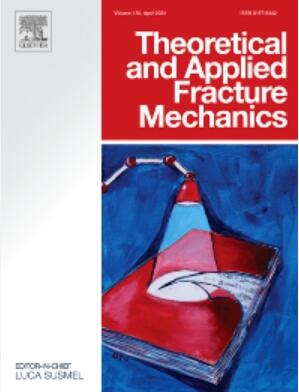Quantification of the stress field associated with mixed-mode I/II crack initiation considering the pre-existing weak interlayers: A photoelastic experimental study using 3D printed transparent models
IF 5
2区 工程技术
Q1 ENGINEERING, MECHANICAL
引用次数: 0
Abstract
Accurate identifying and describing the full-field stress distribution and fracture parameters at the crack tip in rock structures with primary fractures and weak interlayers lay the groundwork for predicting the structural failure behavior of rock masses. This study utilizes 3D printing to create flat-plate models with weak interlayers and open-inclined cracks. The ten-step phase-shift method is applied to obtain the full-field stress of the model. The stress intensity factors at the crack tip are determined using crack multiparameter stress field equations and the nonlinear over-determined least squares method, with an analysis of the method’s reliability. The study explores the effects of mechanical properties, distribution, and length of weak interlayers on the full-field stress difference and stress intensity factor at the crack tip under uniaxial compression. By conducting experiments on low-temperature uniaxial compression, we conducted an analysis of crack propagation characteristics and the influence exerted by weak interlayers. The results indicate the robust reliability of the combination of the ten-step phase-shift method, the multiparametric equation for the crack tip, and the nonlinear over-determined least squares method in evaluating stress intensity factors at the crack tip. The weak interlayer has the potential to shield the principal stress difference and stress intensity factors KI and KII at crack tips, with this shielding effect being influenced by the mechanical properties, distribution, and length of the weak interlayer. The T stress at the crack tip is influenced by the mechanical properties, distribution, and length of the weak interlayer. At −50 ℃, crack propagation undergoes a slow growth stage and a rapid growth stage. The presence of weak interlayers hinders the propagation of cracks and may affect the initiation direction of cracks.
求助全文
约1分钟内获得全文
求助全文
来源期刊

Theoretical and Applied Fracture Mechanics
工程技术-工程:机械
CiteScore
8.40
自引率
18.90%
发文量
435
审稿时长
37 days
期刊介绍:
Theoretical and Applied Fracture Mechanics'' aims & scopes have been re-designed to cover both the theoretical, applied, and numerical aspects associated with those cracking related phenomena taking place, at a micro-, meso-, and macroscopic level, in materials/components/structures of any kind.
The journal aims to cover the cracking/mechanical behaviour of materials/components/structures in those situations involving both time-independent and time-dependent system of external forces/moments (such as, for instance, quasi-static, impulsive, impact, blasting, creep, contact, and fatigue loading). Since, under the above circumstances, the mechanical behaviour of cracked materials/components/structures is also affected by the environmental conditions, the journal would consider also those theoretical/experimental research works investigating the effect of external variables such as, for instance, the effect of corrosive environments as well as of high/low-temperature.
 求助内容:
求助内容: 应助结果提醒方式:
应助结果提醒方式:


